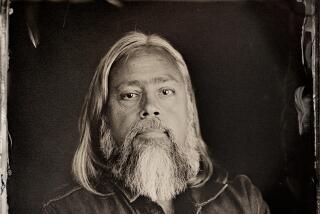Naa Kahidi Troupe Follows Path of Forebears : Theater: Alaskan native group brings ‘wisdom of our grandparents’ to the Irvine Barclay on Tuesday.
- Share via
The Native American legends brought to life by Alaska’s Naa Kahidi Theater, which performs Tuesday at the Irvine Barclay, are more than old tales told to entertain.
“To us,” troupe member Paul M. Jackson declares, “these stories represent the wisdom of our grandparents. They are literally the truth, and as important as anything ever written down.”
In one of the six-member troupe’s dramatizations, Jackson recites these words in Tlingit (pronounced KLINK-et), the melodic language of the Tlingit Native Americans of Southeast Alaska. Most of the Naa Kahidi are Tlingit or Yup’ik, Eskimos from Western Alaska.
Such cultures preserve their heritage and customs by passing stories orally from generation to generation. The ancient art form has been adapted by Naa Kahidi in a mix of oration (in English as well as Tlingit or Yup’ik), dance and mime accompanied by drumming, chanting and flute music. Performers wear traditional regalia and elaborate masks. ( Naa Kahidi is Tlingit for the clan house in which these stories are told.)
The troupe, based in Juneau, was established in 1986 by the Sealaska Heritage Foundation, “a group of elders,” explains Naa Kahidi artistic director Dave Hunsaker, “who thought things would be better for people in Alaska if the rest of the world understood who they are.”
The troupe’s biannual tours “do promote some understanding,” Hunsaker says, “and lead to exchange between us and other people.” Reaching other native Alaskans and preserving the Tlingit and Yup’ik languages also are goals.
“There’s kind of a revival going on now, a renaissance of art and language,” Hunsaker noted on the phone from an earlier tour stop. “But earlier, children were punished if they were heard speaking their native languages.”
One of Naa Kahidi’s pieces, “The Box of Daylight,” is a creation myth. It is about Raven, one of many animals that function as deities or guiding spirits who, as Hunsaker explains it, “brought the stars and the moon and the sun and daylight into the world.”
Raven, depicted by a dancer in a mask with a two-foot beak, “is a trickster god who gets these things through his tricks,” the director continued. “He contrives to have himself born in human form, which he does through a comical immaculate conception. I don’t mean to be blasphemous, but it’s pretty funny.”
The troupe, which must obtain natives’ permission to tell most of the stories, learned another creation myth two years ago from the late Austin Hammond, a charter Naa Kahidi adviser. “The Spirit Came to All Things” is based on the respected elder’s narrative.
“There’s a lot of clear-cutting and logging going on up there,” Hunsaker said, “and Hammond, who was dying and in fact died shortly after we left him, had a real sense of urgency about it. He told us this really old creation story that explains that trees have spirits that need to be respected, valued and used wisely.”
People outside of native cultures often think of Indian legends as unsophisticated children’s stories, Hunsaker said, “something you hear by the campfire as a Boy or Girl Scout.”
While children easily can understand and learn from the 10- to 15-minute stories, “in fact they are incredibly complex,” Hunsaker said, comparing some of the legends to Greek or Shakespearean tragedy.
“Carayak” is an apocalyptic tale of a worldwide famine that leaves few humans alive. One survivor, after learning of her husband’s infidelity, transforms herself into a vicious bear to exact revenge.
In “The Woman Who Married a Bear,” a story of interracial and intercultural relations, a woman says vulgar and disrespectful things about a bear, an act that is taboo in native Alaskan cultures. She then marries a man who turns out to be a bear in human form, and tragedy strikes: The woman will lose either her husband or one of her brothers, who force a fight with the bear.
The stories can offer fresh insights no matter how many times one hears them, Hunsaker said. “The elders say, as your life changes, (the stories) will have different meanings to you. They avoid any sort of moral or statement of purpose, because that’s believed to be limiting.”
“The Peacemaker,” also on Tuesday’s program, represents a departure for Naa Kahidi. It is the troupe’s first piece about a contemporary, non-mythic figure, a former troupe member killed in a freak accident on a fishing trip.
Chris Makua, California bred, was a “hit man,” Hunsaker said, “a killer in one of those big gangs down there” who finally landed in prison. When he got out, a rival gang member slit his throat from ear to ear and he fell into a coma.
“During the coma, Chris had what people from this culture regarded as sort of a spirit dream in which all sorts of things happened to him. The dream precipitated this incredible turning point in his life, and he spent the next 10 years as an apprentice to elders and medicine people, and learned about the old ways and specifically about peacekeeping and healing things.”
He became highly regarded as a healer. “He was an amazingly gentle and wonderful guy, and he had almost no voice (because of the stabbing), but he was an astonishing dancer and a wonderful presence in our company.”
The troupe members looked for an ancient story to pay homage to their friend and to cope with their grief at his untimely death, and when nothing suitable turned up, Hunsaker conceived a modern-day tale. This allegory of a man who finds redemption in his native culture does, however, follow traditional Alaskan storytelling style and incorporates a mask that looks like Makua.
Emotion gripped troupe members when dancer Gene Tagaban first put on the mask.
“We were freaked out,” Hunsaker said. “All of a sudden, there he was!”
*
The Naa Kahidi Theater performs Tuesday at 8 p.m. at the Irvine Barclay Theatre, 4242 Campus Drive, Irvine. $12 to $18. (714) 854-4646.
More to Read
The biggest entertainment stories
Get our big stories about Hollywood, film, television, music, arts, culture and more right in your inbox as soon as they publish.
You may occasionally receive promotional content from the Los Angeles Times.










